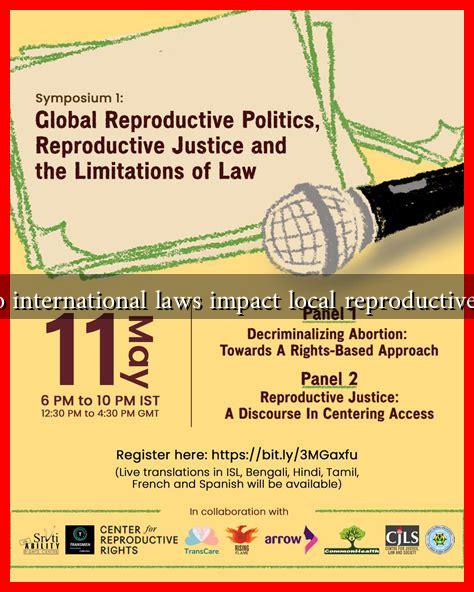-
Table of Contents
- How Do International Laws Impact Local Reproductive Rights?
- The Framework of International Laws on Reproductive Rights
- Case Studies: The Impact of International Laws on Local Practices
- 1. The United States
- 2. Latin America
- 3. Africa
- Challenges in Implementing International Standards
- Conclusion: The Path Forward
How Do International Laws Impact Local Reproductive Rights?
Reproductive rights are a critical aspect of human rights, encompassing the ability of individuals to make informed choices about their reproductive health. These rights are influenced not only by local laws but also by international legal frameworks. This article explores how international laws impact local reproductive rights, examining the interplay between global standards and local practices.
The Framework of International Laws on Reproductive Rights
International laws regarding reproductive rights are primarily derived from various treaties and conventions that aim to protect human rights. Key documents include:
- The Universal Declaration of Human Rights (UDHR): Adopted in 1948, it asserts the right to health and well-being.
- The Convention on the Elimination of All Forms of Discrimination Against Women (CEDAW): Ratified in 1979, it emphasizes women’s rights, including reproductive health.
- The International Covenant on Economic, Social and Cultural Rights (ICESCR): This covenant recognizes the right to the highest attainable standard of health, which includes reproductive health services.
These international frameworks set a baseline for reproductive rights, encouraging countries to adopt laws that align with global standards. However, the implementation of these rights can vary significantly at the local level.
Case Studies: The Impact of International Laws on Local Practices
To understand the impact of international laws on local reproductive rights, we can examine several case studies from different regions:
1. The United States
In the U.S., international treaties like CEDAW have been ratified but not fully integrated into domestic law. This has led to significant disparities in reproductive rights across states. For instance:
- Some states have enacted restrictive abortion laws, limiting access despite international standards advocating for safe and legal abortion services.
- The Supreme Court’s decision in Dobbs v. Jackson Women’s Health Organization (2022) overturned federal protections for abortion, highlighting the tension between local laws and international human rights norms.
2. Latin America
In many Latin American countries, international pressure has led to progressive changes in reproductive rights. For example:
- Countries like Argentina and Mexico have reformed their abortion laws in response to international human rights advocacy.
- The Inter-American Court of Human Rights has ruled that access to safe abortion is a human right, influencing local legislation.
3. Africa
In Africa, the African Charter on Human and Peoples’ Rights has been instrumental in promoting reproductive rights. However, challenges remain:
- Many countries still have restrictive laws regarding abortion and contraception, often influenced by cultural and religious beliefs.
- International organizations, such as the United Nations Population Fund (UNFPA), work to align local laws with international standards, but progress is slow.
Challenges in Implementing International Standards
Despite the existence of international laws, several challenges hinder the effective implementation of reproductive rights at the local level:
- Cultural Resistance: In many societies, cultural norms and religious beliefs can conflict with international standards, leading to resistance against changes in local laws.
- Political Will: The lack of political commitment to uphold international treaties can result in inadequate legal frameworks for reproductive rights.
- Access to Information: Limited access to information about reproductive health can prevent individuals from exercising their rights effectively.
Conclusion: The Path Forward
The impact of international laws on local reproductive rights is profound yet complex. While international frameworks provide a foundation for protecting these rights, local implementation often faces significant hurdles. To enhance reproductive rights globally, it is essential to:
- Strengthen the political will to align local laws with international standards.
- Promote education and awareness about reproductive health rights.
- Encourage collaboration between international organizations and local governments to address cultural and legal barriers.
Ultimately, the journey toward universal reproductive rights requires a concerted effort from all stakeholders, ensuring that individuals can make informed choices about their reproductive health, free from discrimination and coercion.
For further reading on international reproductive rights, visit UNFPA.


